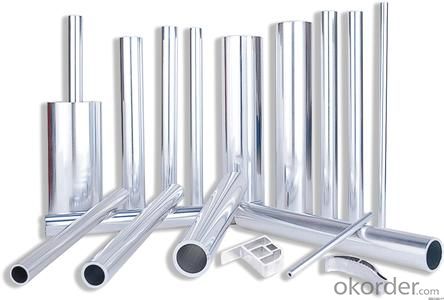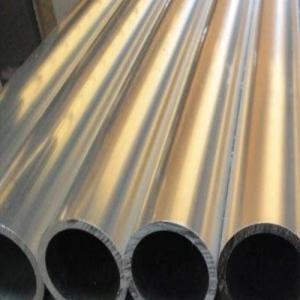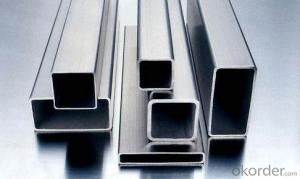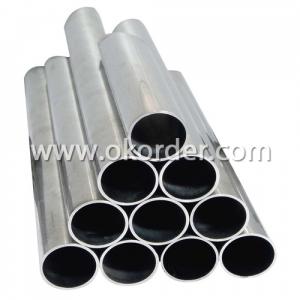Aluminum Pipes and Tubes
OKorder Service Pledge
OKorder Financial Service
You Might Also Like
We are the largest aluminum profilemanufacture in
Provide full size of seamed tubes(Round):
Diameter(Out):7.54mm-573mm
Wall thickness:1mm-44mm
Material | Alloy Aluminum 6063,6061,6005,6082 or customer nominated |
Temper | T3, T4, T5, T6 and other |
Surface | Anodize, electrophoresis, powder coating, PVDF coating, wood grain painting, etc. |
Colour | Any colour based on Standard Germany RAL Mark |
Length | Not more than 16 meters |
Good Package | Inner plastic film /outside carton/wooden pallets |
Payment Method | T/T, L/C, etc |
Delivery Time | Normally 2-4 weeks, Delivery time can be consulted. |
Press Machine | 500-12500 tons all together 93 press lines. |
Fabrication | 1. Furniture 2. Drilling; 3. Bending; 4. Cutting; 5. etc. |
Certificate | ISO/TS 16949,DNV,IRIS,CCS,AFA,etc. |
Dies | 1. Using our dies, no fee; |
2. Using customer drawing, opening dies, usually about 5~50 tons then the dies cost can be refunded. | |
3. Die cost is negotiable base on the order quantity | |
Capability | Annual output 800,000 tons |
- Q: Are aluminum pipes suitable for architectural applications?
- Yes, aluminum pipes are suitable for architectural applications. Aluminum is lightweight, durable, and corrosion-resistant, making it a popular choice for various architectural projects such as structures, façades, and interior design elements. Additionally, aluminum pipes offer flexibility in design, easy installation, and low maintenance requirements, making them an excellent choice for architects and designers.
- Q: Shenzhen Jin Rongfa metal materials Co., Ltd., specializing in processing aluminum tubes, aluminum bars, aluminum plate, aluminum processing, oxidation, a variety of anodic oxidation. Sand blast oxidation. Hard anodized, colors, black, blue, red, tyrant gold, rose goldLathe kits and laser marking processing are also provided!
- 1., a wide range of applications: laser marking machine can be marked on almost all materials. 2., marking efficiency is high: laser marking machine is controlled by the computer, the laser beam can move at high speed, the marking process can be completed in a few seconds, online marking can be achieved. 3., marking precision is high: laser can form very thin beam, in the material surface of the most fine wire width of up to microns, can print all kinds of graphics, trademarks, bar codes, two dimensional code. Laser marking can also improve the appearance, image and brand effect of products, and enhance the market competition ability of products. 4., the use of low cost: laser marking is non-contact marking, not subject to the usual mold marking fatigue service life limit. Maintenance costs are very low in batch processing.
- Q: Can aluminum pipes be used for scaffolding?
- Aluminum pipes are indeed suitable for scaffolding purposes. Due to their lightweight characteristic, high strength-to-weight ratio, and resistance to corrosion, aluminum is widely favored for scaffolding applications. These qualities render aluminum pipes perfect for the construction of scaffolding systems that are simple to handle, transport, and assemble. Moreover, aluminum scaffolding is renowned for its durability and long-lasting nature, making it an economically viable choice in the long term. Nevertheless, it is crucial to ensure that the aluminum pipes employed for scaffolding adhere to the required safety standards and regulations to safeguard the well-being of workers.
- Q: Does GREE have aluminium tubes?
- The original pipe is all copper tube, but the extension should pay attention to guard against immoral, installation work secretly lengthen the aluminum tube
- Q: Can anodized aluminum 6061-T6 surface be oxidized?
- The so-called T6 is a kind of heat treatment, the main process is rolling solid solution and aging, these steps is to let the inner Aluminum Alloy changed, the metal can reach high strength and long deformation, anodic oxidation of our workpiece can have better conductivity and not the impurity content of workpiece the 6061 is too high, a low impurity content of his aluminum alloy aluminum is much less than, so the conductivity of aluminum has good ductility and high anodic oxidation and chemical polishing, is a good choice.
- Q: External diameter 80mm, diameter 23mm, length 500mm, want to use iron pipe to do external mold, internal mold with iron pipe or solid iron rod processing into taper column (and spray boron nitride release agent), do not know such a practice, OK? In this mode with the taper approach in the aluminum liquid after solidification can easily remove aluminum (because the coefficient of thermal expansion than iron, I am afraid after cooling tubes will (lock core) trouble experienced teacher for advice! Thank you! StopWell, I'll make a small tube of plaster. If the inner mold is not working, will it be stuck together with the aluminum parts? It's not good to clean it
- A drill bit that is not so long can be welded longer.Or you can't buy this round bar.
- Q: What are the different coating options for aluminum pipes?
- Some common coating options for aluminum pipes include powder coating, anodizing, and painting. Powder coating involves applying a dry powder onto the surface which is then heated to create a protective and decorative coating. Anodizing creates a durable oxide layer on the aluminum surface using an electrochemical process. Painting involves applying a liquid paint coating onto the aluminum pipes, providing protection and aesthetic appeal.
- Q: Please help to analyze the cause of the formation Fifty1070 aluminum rods are made of aluminum tubes from extrusion units. The process is: extrusion, melting - the mold passes through (the formation of aluminum tubes) - tap water cooling - closing - nitrogen charging and pressure maintaining. Therefore, the internal pipeline is nitrogen protection, and after a period of time, the pipeline will appear white powder, affecting resistance welding, welding is not firm, easy to fall off and leak.
- This is caused by the oxidation of aluminum tubes. It is usually in the rainy season. The humidity in the air increases, and it is oxidized by the long contact with the inner wall of the aluminum tube.
- Q: Can aluminum pipes be used for swimming pool systems?
- Absolutely, swimming pool systems can indeed utilize aluminum pipes. Aluminum, being a lightweight and highly resistant material against corrosion, proves to be an ideal selection for pool systems. It is extensively employed in the piping systems of both residential and commercial swimming pools. The durability and longevity of aluminum pipes are widely recognized, given their ability to withstand even the harshest weather conditions and exposure to chemicals. Moreover, aluminum pipes exhibit exceptional heat conductivity, guaranteeing an efficient transfer of heat for pool heating or cooling systems. All in all, aluminum pipes present themselves as a dependable and economically viable choice for swimming pool systems.
- Q: Why is the aluminum tube welded with stainless steel gasket ring?
- Because the aluminum welding iron collapsed, so with stainless steel pad ring, can also use the aluminum ring pad with the same material
Send your message to us
Aluminum Pipes and Tubes
OKorder Service Pledge
OKorder Financial Service
Similar products
Hot products
Hot Searches
Related keywords























